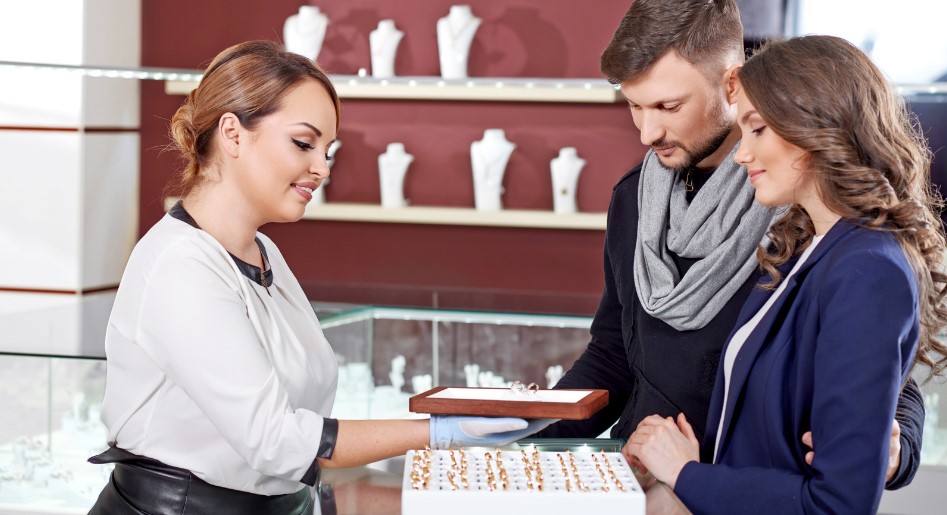Starting a jewelry business can be a rewarding venture, especially with the growing global jewelry market. If you’ve always had a passion for jewelry and dreamt of starting your own company, now is the perfect time to turn that dream into a reality. But where do you begin?
In this comprehensive guide, we will provide you with valuable insights on how to start a jewelry business, from finding your niche in the industry to setting up a dedicated workspace. Whether you’re an aspiring entrepreneur or a jewelry enthusiast looking to take the next step, this article will provide you with the essential tips and strategies to launch your own successful jewelry venture.
By following our step-by-step advice, you’ll be well-equipped to start your own jewelry business and pave your way to success in this thriving industry. So, let’s dive in and explore the exciting world of jewelry entrepreneurship!
How to Start a Jewelry Business Successfully?
The essential steps for starting a jewellery business in the UK:
- Finding your niche in the jewelry industry
- Researching market trends
- Defining your brand
- Deciding whether to produce or source your jewelry products
- Setting up a jewelry business studio or workspace
- Taking professional photos of your products
Find Your Niche in the Jewelry Industry
When setting up a jewellery business, it’s important to find your niche in the industry. The jewelry market offers various categories and niches to choose from, allowing you to establish a unique position in the market. Whether you’re interested in fine jewelry, costume jewelry, or artist-designed pieces, determining the type of jewelry you want to sell is a crucial first step.
Consider your target audience and narrow down your focus. Will your products cater to a specific occasion, such as weddings or anniversaries, or will they be designed for everyday wear? This decision will help you identify the right market segment and tailor your offerings accordingly.
Within your chosen niche, explore different types of jewelry products to diversify your business. You can consider offering a range of products, including:
- Rings
- Necklaces
- Bracelets
- Earrings
- Watches
By expanding your offerings, you can attract a broader customer base and cater to different preferences. It’s also worth exploring complementary products and categories that align with your niche. For example, if you specialize in vintage-inspired jewelry, you can also offer accessories like hairpieces or brooches to complement your main products.
Market Trends Quote:
“Stay updated on the latest jewelry trends to ensure your offerings align with the current market demand.” – Jewelry Expert
Researching market trends is essential to stay ahead in the ever-evolving jewelry industry. By staying informed about the latest styles, materials, and design preferences, you can create jewelry that resonates with your target audience. Monitoring fashion and jewelry blogs, following influencers, and using tools like Google Trends can provide valuable insights into customer preferences.
Through thorough market research and understanding of your target audience, you can find your niche in the jewelry industry. By offering unique and appealing products within your chosen category, you can establish a compelling brand that stands out from the competition.
Research Market Trends
When starting a jewelry business in the UK online, it’s important to stay updated on the latest market trends. By researching jewelry market trends, you can gain valuable insights into consumer preferences and adapt your offerings accordingly.
One way to stay informed is by reading fashion and jewelry blogs. These online resources often highlight emerging styles, popular designs, and industry news. By keeping an eye on these sources, you can identify trends that are gaining traction and incorporate them into your product line.
Another effective strategy is to follow influencers in the jewelry industry. Influencers often have their finger on the pulse of current trends and can provide inspiration for your own designs. Pay attention to the types of jewelry they feature, the materials they use, and the styles they promote.
Additionally, utilizing tools like Google Trends can help you research global search volume for different jewelry-related keywords. This data can give you insights into popular search terms and topics, allowing you to tailor your content and marketing efforts to attract more potential customers.
While it’s important to follow existing trends, don’t be afraid to create your own. By offering unique designs and styles that resonate with your target audience, you can establish your jewelry business as a trendsetter in the market.
Consider adjacent consumer trends as well, such as customization or sustainable shopping. These trends reflect changing customer preferences and can provide opportunities for your business to cater to specific niches within the market.
In summary, researching jewelry market trends is a key step in starting a successful jewelry business in the UK online. By staying informed, following influencers, and analyzing search data, you can identify current and emerging trends that will guide your product development and marketing strategies.

Define Your Brand
When starting a jewelry business, one of the most important steps is to define your brand. Your brand is what sets you apart from your competitors and helps establish a connection with your target audience. Here are some key considerations to keep in mind:
- Brand Voice: Determine the tone, language, and style of communication that best represents your brand. Consider how you want your brand to be perceived and use a consistent voice across all your marketing channels.
- Mission and Vision: Clearly define your business’s purpose and long-term goals. Your mission statement should reflect what your brand stands for and how it aims to make a difference in the jewelry industry.
- Storytelling: Share the story behind your brand and create an emotional connection with your customers. Communicate the inspiration, craftsmanship, and passion that goes into each piece of jewelry you offer.
- Target Audience: Gain a deep understanding of your target audience’s preferences, values, and desires. Tailor your brand messaging to resonate with their needs and aspirations.
Once you have defined your brand’s essence, it’s time to bring it to life through visual elements:
- Logo: Design a unique and memorable logo that represents your brand’s identity. Your logo should be simple, versatile, and easily recognizable.
- Packaging: Create packaging that reflects the quality and style of your brand. Invest in materials that enhance the unboxing experience and leave a lasting impression on your customers.
- Visual Elements: Consistency is key when it comes to visual branding. Choose a color palette, typography, and imagery that align with your brand’s personality and values.
It’s also essential to consider the legal requirements and necessary permits for starting a jewelry business in the UK. Ensure compliance with hallmarking regulations and any other relevant legislation.
“Your brand is what people say about you when you’re not in the room.”

Produce or Source Your Jewelry Products
When starting a small jewellery business in the UK, you have the option to either produce your own jewelry products or source them from trusted suppliers. Each approach has its own advantages and considerations that you need to take into account.
“Deciding whether to produce or source your jewelry products is an important step in establishing your business. Consider your resources, skills, and goals to make an informed decision.”
If you choose to produce your jewelry products, you have more control over the design, quality, and customization options. It allows you to showcase your creativity and unique style. However, it also requires an investment in equipment, tools, and materials.
On the other hand, sourcing your products can be a more cost-effective and time-efficient option, especially when you’re just starting out. By establishing relationships with reliable suppliers and manufacturers, you can access a wide variety of jewelry products without the need for production facilities.
Legal Requirements for Selling Jewellery
Regardless of whether you produce or source your jewelry products, it’s essential to comply with the legal requirements for selling jewellery in the UK. This ensures consumer protection and maintains the integrity of the industry.
One of the key legal requirements is hallmarking. In the UK, precious metal jewelry must be hallmarked to guarantee its quality and authenticity. The hallmark certifies the metal content of the jewelry, such as gold, silver, or platinum, and is recognized by both consumers and industry professionals. It provides reassurance to customers and builds trust in your brand.
In addition to hallmarking, there may be other certifications or regulations specific to certain types of jewelry products. For example, if you’re selling diamonds, you need to adhere to the Kimberley Process Certification Scheme to ensure ethical sourcing and prevent conflict diamonds from entering the market.
It’s important to research and understand the legal requirements for selling jewelry in the UK to avoid any potential legal issues or penalties. Consult with industry experts or regulatory bodies, such as the Assay Office, to ensure compliance and stay updated on any changes or new regulations.
| Produce Your Jewelry Products | Source Your Jewelry Products |
|---|---|
| ✓ More control over design and quality | ✓ Cost-effective and time-efficient |
| ✓ Showcases creativity and unique style | ✓ Access to a wide variety of products |
| ✓ Opportunity for customization | ✓ No need for production facilities |
| ✓ Builds brand reputation | ✓ Established relationships with suppliers |
Quality control is crucial regardless of whether you produce or source your jewelry products. Ensure that the products meet your standards and the expectations of your customers. Conduct thorough inspections and have a clear process in place to address any issues or concerns that may arise.
Choosing between producing or sourcing your jewelry products depends on various factors, including your resources, expertise, and business goals. Consider the advantages and legal requirements associated with each option to make an informed decision that aligns with your vision for your small jewelry business in the UK.

Set Up a Jewelry Business Studio or Workspace
Creating a dedicated workspace is essential when starting a jewelry business. By setting up a well-equipped studio, you can streamline your operations and maximize productivity. Here are some key steps to help you establish a functional jewelry workspace:
- Lighting: Ensure your studio has ample lighting to accurately assess the color, sparkle, and overall quality of your jewelry pieces. Natural light is ideal, so position your workspace near a window or invest in bright, daylight-simulating LED lights.
- Storage: Organize your materials and tools efficiently by investing in storage solutions. Consider storage cabinets, drawers, and bins to keep your beads, gemstones, findings, and other supplies neatly arranged and easily accessible.
- Work surfaces: Dedicate a sturdy workbench or table for your jewelry-making activities. Choose a surface that allows you to work comfortably and provides ample space to lay out your tools, materials, and ongoing projects.
- Jewelry making tools and equipment: Equip your studio with the necessary tools and equipment to create your jewelry pieces. Some essential items include pliers, cutters, files, hammers, and a jeweler’s bench pin. Additionally, consider investing in specialized tools based on your chosen jewelry-making techniques and designs.
- Online inventory system: If you’re starting an online jewelry business, implement an efficient inventory system to track your products. This system will help you manage stock levels, monitor sales, and easily fulfill orders.
- Packaging materials: For online sales, ensure you have appropriate packaging materials to protect your jewelry during shipping. Invest in padded envelopes, jewelry boxes, bubble wrap, and shipping labels to create a professional and safe packaging experience for your customers.
Creating an Inspiring Workspace
While functionality is crucial, it’s also important to create a workspace that inspires your creativity and reflects your brand’s aesthetic. Add personal touches, such as artwork or plants, to make the space feel inviting and comfortable.
Remember, a well-organized studio or workspace sets the foundation for a successful jewelry business. With the right tools, materials, and environment, you can efficiently produce high-quality jewelry pieces that captivate your customers.
Now that you have your jewelry studio in place, it’s time to showcase your stunning creations through captivating product photography. Continue reading to learn how to take professional photos of your jewelry products.
| Advantages | Disadvantages |
|---|---|
| Dedicated workspace increases efficiency | Initial setup costs for tools and equipment |
| Well-organized storage enhances productivity | Requires space allocation |
| Online inventory system simplifies management | Additional investment for packaging materials |
Take Professional Photos of Your Products
High-quality product photos are essential for launching a jewelry brand and showcasing your products online. To capture stunning images that attract potential customers and enhance your brand image, follow these tips:
- Invest in a good camera or hire a professional photographer: A high-resolution camera with good lighting capabilities will ensure that your jewelry is captured in exquisite detail. If you don’t have photography skills, consider hiring a professional photographer who specializes in product photography.
- Set up a photography area: Dedicate a specific area for product photography. Make sure it has ample natural light or invest in studio lighting equipment to create a well-lit and controlled environment. Choose a neutral background or use props that complement your jewelry to create visually appealing images.
- Take detailed shots: Capture multiple angles and close-ups of each piece of jewelry. This helps potential customers see the craftsmanship and design in detail. Highlight any unique features or intricate patterns to make your products stand out.
- Consistency is key: Maintain a consistent style and aesthetic across all your product photos. This helps create a cohesive brand image and improves customer recognition. Consider using the same backdrop, lighting, and editing techniques for all your images.
Ensure that your images are properly optimized for the web by resizing them to an appropriate resolution and compressing them without compromising on quality. With visually appealing and professional product photos, you can effectively showcase your jewelry and significantly increase your chances of success in starting a jewelry business in the UK online.
“Good photography is like a silent salesperson, attracting customers and telling your brand’s story without saying a word.”
Conclusion
Starting a jewellery business requires careful planning and attention to detail. By finding your niche, conducting market research, and defining your brand, you can set the foundation for a successful venture in the jewellery industry. Whether you choose to produce your own jewellery or source products from reliable suppliers, creating a dedicated workspace and taking professional product photos will add credibility to your business.
Implementing effective marketing strategies is crucial for promoting your online jewellery brand and attracting customers. Utilize social media platforms, optimize your website for search engines, and engage with your target audience through meaningful content. Remember to continuously analyze market trends and adapt your offerings to meet evolving customer preferences.
With dedication, creativity, and a comprehensive business plan, you can turn your passion for jewellery into a thriving business. Starting a jewellery company may seem challenging, but by following this startup guide and staying focused on your goals, you can build a successful and profitable venture in the captivating world of jewellery.
FAQ
How do I research market trends for my jewelry business?
To research market trends for your jewelry business, you can read fashion and jewelry blogs, follow influencers, and use tools like Google Trends to analyze global search volume. Stay updated on the latest jewelry trends and consider adjacent consumer trends, such as customization and sustainable shopping.
How important is it to define my brand in the jewelry business?
Defining your brand is crucial in the jewelry business. It helps you connect with customers on an emotional level and differentiate yourself from competitors. Define your brand’s voice, mission, vision, and story. Incorporate the language of your target audience into your brand’s voice and develop visual elements that align with your brand identity, such as a logo and packaging.
Should I produce or source my jewelry products?
Whether you choose to produce or source your jewelry products depends on your capabilities and preferences. If you decide to produce them, invest in the necessary equipment, tools, and materials. Ensure compliance with legal requirements for selling jewelry in the UK, including hallmarking and certifications. If you source your products, establish relationships with reliable suppliers and manufacturers and prioritize quality control.
How can I take professional photos of my jewelry products?
Taking professional photos of your jewelry products is essential for showcasing them online. Invest in a good camera or hire a professional photographer. Set up a photography area with appropriate lighting and backgrounds. Take detailed shots, including close-ups, to highlight the craftsmanship and design of each piece. Consistent and visually appealing product photos will attract potential customers and enhance your brand image.




